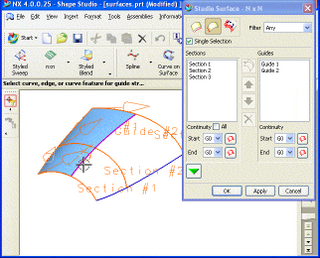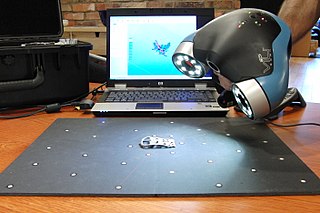Related Research Articles

Computer-Aided Design (CAD) is the use of computers to aid in the creation, modification, analysis, or optimization of a design. This software is used to increase the productivity of the designer, improve the quality of design, improve communications through documentation, and to create a database for manufacturing. Designs made through CAD software are helpful in protecting products and inventions when used in patent applications. CAD output is often in the form of electronic files for print, machining, or other manufacturing operations. The terms computer-aided drafting (CAD) and computer-aided design and drafting (CADD) are also used.

A point cloud is a discrete set of data points in space. The points may represent a 3D shape or object. Each point position has its set of Cartesian coordinates. Point clouds are generally produced by 3D scanners or by photogrammetry software, which measure many points on the external surfaces of objects around them. As the output of 3D scanning processes, point clouds are used for many purposes, including to create 3D computer-aided design (CAD) models for manufactured parts, for metrology and quality inspection, and for a multitude of visualizing, animating, rendering, and mass customization applications.
Creo Parametric, formerly known, together with Creo Elements/Pro, as Pro/Engineer and Wildfire, is a solid modeling or CAD, CAM, CAE, and associative 3D modeling application, running on Microsoft Windows.

Non-uniform rational basis spline (NURBS) is a mathematical model using basis splines (B-splines) that is commonly used in computer graphics for representing curves and surfaces. It offers great flexibility and precision for handling both analytic and modeled shapes. It is a type of curve modeling, as opposed to polygonal modeling or digital sculpting. NURBS curves are commonly used in computer-aided design (CAD), manufacturing (CAM), and engineering (CAE). They are part of numerous industry-wide standards, such as IGES, STEP, ACIS, and PHIGS. Tools for creating and editing NURBS surfaces are found in various 3D graphics and animation software packages.
Autodesk 3ds Max, formerly 3D Studio and 3D Studio Max, is a professional 3D computer graphics program for making 3D animations, models, games and images. It is developed and produced by Autodesk Media and Entertainment. It has modeling capabilities and a flexible plugin architecture and must be used on the Microsoft Windows platform. It is frequently used by video game developers, many TV commercial studios, and architectural visualization studios. It is also used for movie effects and movie pre-visualization. 3ds Max features shaders, dynamic simulation, particle systems, radiosity, normal map creation and rendering, global illumination, a customizable user interface, and its own scripting language.

Solid modeling is a consistent set of principles for mathematical and computer modeling of three-dimensional shapes (solids). Solid modeling is distinguished within the broader related areas of geometric modeling and computer graphics, such as 3D modeling, by its emphasis on physical fidelity. Together, the principles of geometric and solid modeling form the foundation of 3D-computer-aided design and in general support the creation, exchange, visualization, animation, interrogation, and annotation of digital models of physical objects.

SolidWorks is a solid modeling computer-aided design (CAD) and computer-aided engineering (CAE) application published by Dassault Systèmes.

Freeform surface modelling is a technique for engineering freeform surfaces with a CAD or CAID system.

3D scanning is the process of analyzing a real-world object or environment to collect three dimensional data of its shape and possibly its appearance. The collected data can then be used to construct digital 3D models.

Rhinoceros is a commercial 3D computer graphics and computer-aided design (CAD) application software that was developed by Robert McNeel & Associates, an American, privately held, and employee-owned company that was founded in 1978. Rhinoceros geometry is based on the NURBS mathematical model, which focuses on producing mathematically precise representation of curves and freeform surfaces in computer graphics.

Solid Edge is a 3D CAD, parametric feature and synchronous technology solid modeling software. It runs on Microsoft Windows and provides solid modeling, assembly modelling and 2D orthographic view functionality for mechanical designers. Through third party applications it has links to many other Product Lifecycle Management (PLM) technologies.

Seamless3d is an open-source 3D modeling software available under the MIT license.

Synopsys Simpleware ScanIP is a 3D image processing and model generation software program developed by Synopsys Inc. to visualise, analyse, quantify, segment and export 3D image data from magnetic resonance imaging (MRI), computed tomography (CT), microtomography and other modalities for computer-aided design (CAD), finite element analysis (FEA), computational fluid dynamics (CFD), and 3D printing. The software is used in the life sciences, materials science, nondestructive testing, reverse engineering and petrophysics.

Cobalt is a parametric-based computer-aided design (CAD) and 3D modeling program that runs on both Macintosh and Microsoft Windows operating systems. The program combines the direct-modeling way to create and edit objects and the highly structured, history-driven parametric way exemplified by programs like Pro/ENGINEER. A product of Ashlar-Vellum, Cobalt is Wireframe-based and history-driven with associativity and 2D equation-driven parametrics and constraints. It offers surfacing tools, mold design tools, detailing, and engineering features. Cobalt includes a library of 149,000 mechanical parts.

In 3D computer graphics, 3D modeling is the process of developing a mathematical coordinate-based representation of any surface of an object in three dimensions via specialized software by manipulating edges, vertices, and polygons in a simulated 3D space.
Geomagic is the professional engineering software brand of 3D Systems. The brand began when Geomagic Inc., a software company based in Morrisville, North Carolina, was acquired by 3D Systems in February 2013 and combined with that company's other software businesses. Geomagic was founded in 1997 by Ping Fu and Herbert Edelsbrunner.
Solid Modeling Solutions is a company who has an implementation of a mathematical representation of many NURBS, 3D geometry, and Solid modeling technology which emerged in the 1980s and 1990s into a commercial implementation known as SMLib. This article will provide the background and history of this implementation into a commercial product line from Solid Modeling Solutions (SMS). SMS is an independent supplier of source code for a powerful suite of 3D geometry kernels. SMS provides advanced NURBS-based geometry libraries, SMLib, TSNLib, GSNLib, NLib, SDLib, VSLib, and PolyMLib, that encompass extensive definition and manipulation of NURBS curves and surfaces with the latest fully functional non-manifold topology.

SolveSpace is a free and open-source 2D/3D constraint-based parametric computer-aided design (CAD) software that supports basic 2D and 3D constructive solid geometry modeling.

Freeform surface or complex surfaces are widely manufactured nowadays. The industries which most often manufactures free-form surfaces are basically aerospace, automotive, die mold industries, bio medical and power sector for turbine blades manufacturing. Generally 3 or 5 axis CNC milling machine is used for this purpose. The manufacturing process of free form surface is not an easy job as the tool path generation in present CAM technology is generally based on geometric computation so tool path are not optimum. The geometry can also be not described explicitly so errors and discontinuities occurrence in the solid structure cannot be avoided. Free-form surfaces are machined with the help of different tool path generation method like adaptive iso-planar tool path generation, constant scallop tool path generation, adaptive iso-parametric method, iso-curvature, isophote and by other methods. The different methods are chosen based on the parameters which is needed to be optimized.
References
- ↑ "Power Surfacing - Advanced Surfacing for SOLIDWORKS - Solid Solutions". Solid Solutions. Retrieved 2023-04-17.
- 1 2 3 4 "Power Surfacing | SOLIDWORKS". SOLIDWORKS. Retrieved 2023-04-17.
- ↑ Pasin, Utku (2021). Generative Modelling and Artificial Intelligence for Structural Optimization of a Large Span Structure (PDF). Torino: Politecnico di Torino. p. 22.
- ↑ "Power Surfacing for SolidWorks® Video Tutorials - nPowerSoftware". nPowerSoftware. Retrieved 2023-04-17.
- ↑ Vergunova, Nataliia; Vergunov, Sergey (2023). Arsenyeva, Olga; Romanova, Tatiana; Sukhonos, Maria; Tsegelnyk, Yevgen (eds.). "Optimization of Design Process Based on 3D-Model". Smart Technologies in Urban Engineering. Lecture Notes in Networks and Systems. Cham: Springer International Publishing. 536: 45–56. doi:10.1007/978-3-031-20141-7_5. ISBN 978-3-031-20141-7.
- ↑ Tyflopoulos, Evangelos; Lien, Mathias; Steinert, Martin (January 2021). "Optimization of Brake Calipers Using Topology Optimization for Additive Manufacturing". Applied Sciences. 11 (4): 1437. doi: 10.3390/app11041437 . ISSN 2076-3417.
- ↑ BEN CHOHRA, Mustapha; BEN ADDA, Nassim; ABDELLAH, El Hadj (2018). "Conception d'un moule d'une bouteille de shampoing". Constriction mécanique (MF 3926).
- ↑ Aydin, Levent; Kucuk, Serdar; Cakir, Ozgur (2019-12-13). "Patient Specific Cardiovascular Disease Modelling Based on the Computational Fluid Dynamics Simulations: Segmentation and Hemodynamic Model of a Thoracic Artery". Journal of Polytechnic. 23 (4): 1213–1218. doi:10.2339/politeknik.616293. ISSN 1302-0900. S2CID 210705115.
- ↑ Glatzeder, Korbinian; Komnik, Igor; Ambellan, Felix; Zachow, Stefan; Potthast, Wolfgang (2022-10-07). "Dynamic pressure analysis of novel interpositional knee spacer implants in 3D-printed human knee models". Scientific Reports. 12 (1): 16853. doi:10.1038/s41598-022-20463-6. ISSN 2045-2322. PMC 9546830 . PMID 36207344.